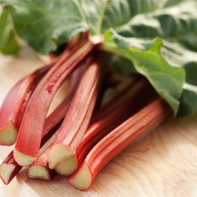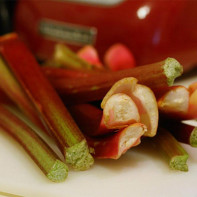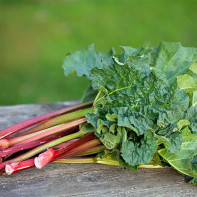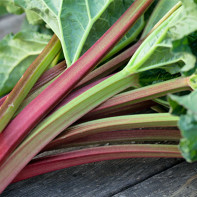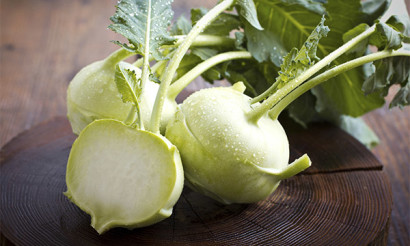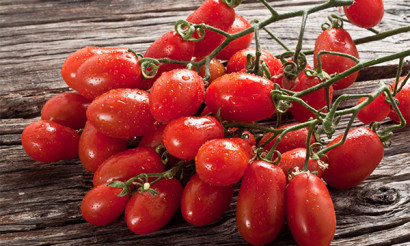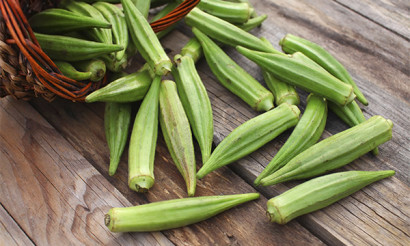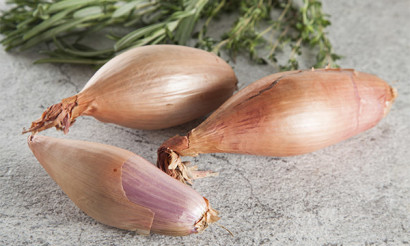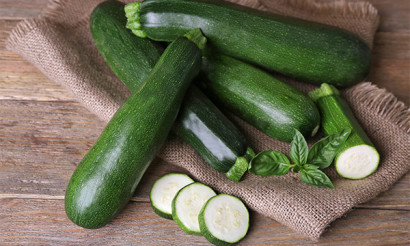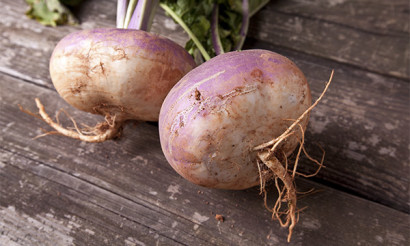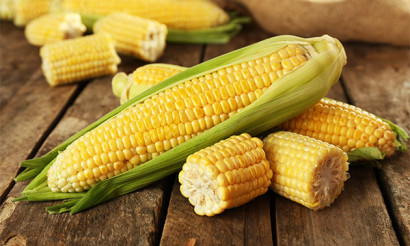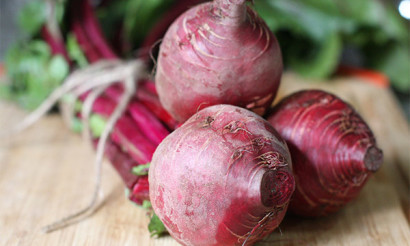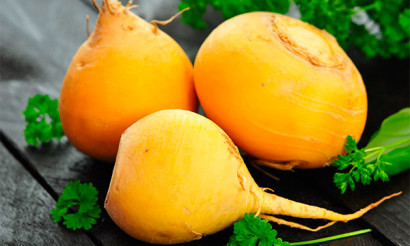Rhubarb: benefits and harms to the human body
Inexperienced people often take rhubarb sprouts for beets because of a raspberry-colored stem and large succulent leaves. Some sources claim that the plant comes from Tibet, while others refer to China. One way or another, many countries have successfully cultivated rhubarb. Among them are Asia, Europe, America.
- Composition and calorie content
- What is useful rhubarb
- For women
- For men
- During pregnancy
- When breastfeeding
- For kids
- The benefits of rhubarb for weight loss
- The healing properties of rhubarb root
- Rhubarb in cosmetology
- For face
- For hair
- Harm and contraindications
- How to choose and store rhubarb
- What can be prepared from rhubarb: recipes
- Jam
- Compote
- Candied fruit
- Soup
- Kissel
- Interesting facts about rhubarb
Composition and calorie content
The composition of the plant includes 90% of pure water and 10% of carbohydrates, fats, proteins, ash and dietary fiber.
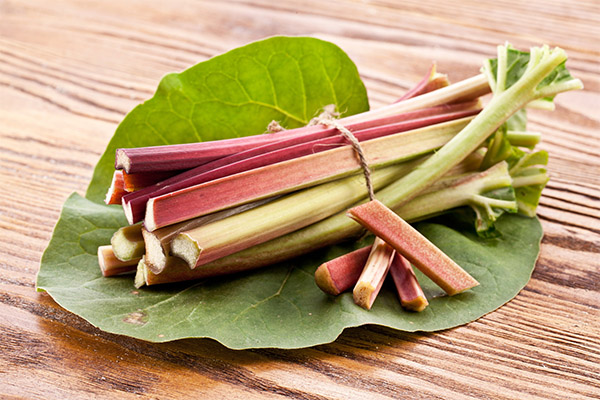
With increasing temperature, the rhubarb petioles tend to coarse and accumulate oxalic acid. Calorie content of the plant is only 16 kcal per 100 grams of product.
In rhubarb, only leaf petioles are usually eaten. The leaf plate contains a high concentration of oxalic acid. Using it in such quantities can cause irritation, blockage, and even ruptures of the renal tubules, where salt crystals - oxalates - precipitate.
What is useful rhubarb
For medicinal purposes, the plant is used not only in traditional, but also in folk medicine. Rhubarb is an excellent prophylactic for vitamin deficiency, anemia and scurvy. In addition, rhubarb is able to inhibit the development of pneumonia and increases immunity to various viral diseases. It has a very positive effect on the functioning of the cardiovascular system, preventing the occurrence of heart attacks or ischemic strokes.
For women
For women, rhubarb is especially useful:
- Due to the high concentration of vitamin E, the general condition of the body, nails and skin improves. Hair loss is reduced, their growth is enhanced.
- Tinctures from the roots have an antispasmodic effect, which is very important for girls with a painful menstrual cycle.
- It has excellent whitening properties, which allows the plant to be used to remove age spots and freckles.
- In addition, it is a powerful antioxidant, which contributes to the activation of the rejuvenation of the female body.
For men
For men, the use of this plant is useful in the following cases:
- The presence of cardiovascular disease - improves blood circulation, lowers cholesterol, dilates blood vessels.
- Frequent use of tobacco and alcohol products - neutralizes the negative impact on the body, helps to eliminate toxins, reduces hangover.
During pregnancy
First of all, gynecologists advise pregnant women to eat rhubarb because of its ability to thicken blood. This can reduce the risk of bleeding during childbirth. And also the stems of the plant contain many substances necessary for the woman's body:
- vitamins of groups B, E, C, P;
- succinic, malic, oxalic and citric organic acids;
- pectins and their derivatives.
In addition, it has the following useful properties:
- Replenishes the body's need for vitamin K, the norm of which for a woman in position is 85–90 ml. It is necessary to normalize the process of blood thickening and prevent hemorrhage in the fetal brain during childbirth.
- Does not allow the girl to develop hypertension.
- Due to the ban on pharmaceutical pharmacological preparations, rhubarb is an effective analogue for normalizing blood pressure.
- The plant reduces the level of cholesterol in the blood and helps strengthen the walls of blood vessels, making them more elastic.
- For the proper development and strengthening of bones and teeth in a child, a woman needs calcium. One cup of rhubarb contains about 348 ml of the mineral.It also positively affects the development and growth of embryonic nerves, muscles and the heart.
When breastfeeding
During lactation, the use of this vegetable is better to limit or eat with extreme caution. The high acid content in it can harm the health of the child. Most often, doctors forbid nursing mothers to eat it. In extreme cases, jam or stewed fruit can be made from a small amount of heat-treated product. But it’s better to try to do without it for a while.
For kids
You can give a child rhubarb from 10-12 months. The product will bring special benefits to children suffering from constipation. In no case should you give them fresh stems - only a light compote. After two years, it is recommended to switch to rhubarb syrup. As well as young sprouts increase appetite. They need to be slightly sweetened to reduce acid taste. But it should be remembered that what is eaten beyond measure can cause severe damage to the walls of the stomach.
The reaction of the child's body to the product is exclusively individual. You can mitigate the effects of acid by combining rhubarb with other products. For example, cook jelly. And with spring vitamin deficiency, a light vegetable soup with young roots and various vegetables (potatoes, carrots, onions, greens, young peas) will be useful. If the child does not want to eat them whole, you can make cream soup by whipping everything with a blender.
The benefits of rhubarb for weight loss
Dieting on rhubarb is not difficult because you will not need to starve yourself or learn how to cook complicated dishes. But there are several important nuances. First of all, you need to pay enough attention to the condition of your body, in particular the organs of the gastrointestinal tract, and at the first signs of digestive upset immediately stop taking the product. In addition, it is important to observe the dosage - in large quantities, rhubarb will do health more harm than good. To achieve the desired effect, one serving of a meal per day will suffice.
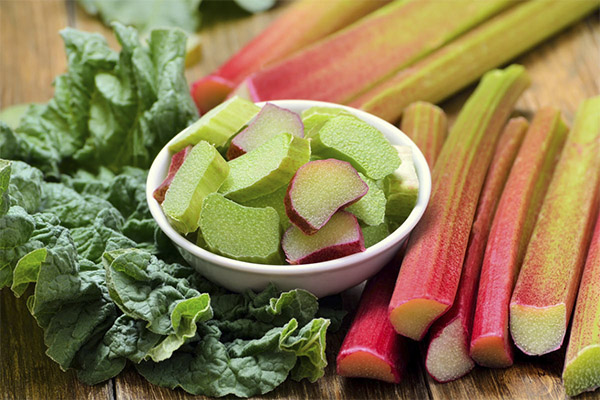
For a rhubarb diet, you can prepare a salad with cucumber, tomato, bell pepper, onion, cabbage or radish. Without fail, a large amount of greenery should be present in it. And also any healthy drink without added sugar will do. You can cook it by adding mint, lemon balm, apple or orange juice. It all depends on the taste preferences of the person.
During the period of weight loss it is allowed to eat almost all products, with the exception of muffins and sweets. And also you need to remember that it is advisable to cook steamed, stew or bake dishes. Rhubarb cannot be fried. In addition, it is important not to forget about the body's water balance. Pure water, sugar-free compotes, green tea, juices, mineral water should be present in the diet in sufficient quantities daily.
The healing properties of rhubarb root
The level of medicinal properties of the plant is directly related to the collection period and the quality of the harvested product. To prepare a decoction of hepatitis, the roots must meet the following requirements:
- age - 3-4 years;
- collected from August to November inclusive;
- there should be no rotten or corroded parts by worms;
- dried to a state of uniform density at a temperature of + 65 ° C.
With proper preparation, the product has a bitter taste and a peculiar aroma. And also he must grind on his teeth when chewing. Fresh roots of dark red color, dried - faded red-yellow, with small spots.
Due to the high content of macro- and microelements, the plant has the following healing properties:
- strengthens the immune system;
- improves digestion and cleanses the intestines;
- helps to maintain weight;
- helps to remove toxins from the body;
- has a choleretic effect;
- contributes to the normalization of the nervous system;
- eliminates puffiness;
- strengthens the cardiovascular system;
- normalizes blood pressure;
- eliminates anemia;
- improves the formation of cartilage, bones and tissues, which helps to prevent the development of osteoporosis;
- heals wounds and skin diseases;
- gives anti-inflammatory effect.
- treats complex diseases such as vitiligo and psoriasis.
Rhubarb in cosmetology
Juice from the roots of the plant is often used as a kind of foundation because of its ability to give the skin a light shade of tan. This is especially true for those who suffer from a disease such as vitiligo.
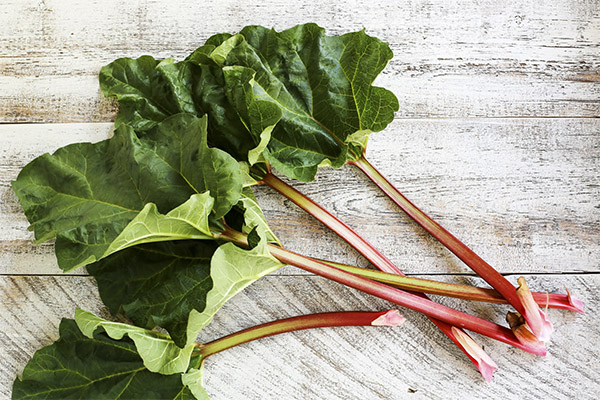
For face
Rhubarb can help even out the overall tone of the epidermis. Simply lubricate the affected areas with juice from the root and leave for 10-15 minutes. Wash off with warm water. It is important to remember that after the procedure for some time you can not be exposed to direct sunlight.
A similar effect can be achieved by combining a regular cream to moisturize the skin and rhubarb juice in a ratio of 1: 1. Apply the mixture on the skin and wash off after 15 minutes.
Rhubarb is also an excellent tool for whitening freckles and age spots. To prepare a special mask you will need:
- petioles of rhubarb - 2 tablespoons;
- chopped oatmeal - 1 tbsp;
- cream 15% - 1 tablespoon
All ingredients should be thoroughly mixed and the resulting mass applied to the skin, leave for 25-30 minutes and rinse with warm water.
To improve and cleanse oily skin with a tendency to acne, you can use the following recipe:
- crushed rhubarb cuttings - 2 tbsp .;
- glycerin - 1 tbsp;
- beaten egg white - 1 pc.
Mix everything thoroughly, apply on face skin and leave for 15-20 minutes. Then rinse with warm water. To achieve the desired effect, the mask should be used every other day. Only 8-10 times.
The plant also helps in the fight against acne. You need to make a special compress by mixing the crushed rhubarb rhizomes with vinegar. If necessary, this method will help against abrasions and bruises.
A tonic based on this vegetable will be very useful and nutritious for the skin of the face. You will need:
- finely ground roots of rhubarb - 3 tablespoons;
- boiling water - 0.25 l;
- honey - 1 tbsp
Mix all the ingredients and allow the mass to infuse until completely cooled, and then filter. Wipe your face twice a day. The tonic is stored in the refrigerator.
For hair
The roots of the plant are used to give hair splendor and shine, as well as for easy lightening.
In the first case, you will need:
- shredded roots - 1 tbsp;
- boiling water - 1 l.
Pour and let it brew for half an hour. Then cool and use as a rinse after washing your hair with shampoo.
For hair coloring you will need:
- crushed rhubarb roots - 25 g;
- cold water - 0.25 liters.
Boil the resulting mixture for 20 minutes, stirring constantly. After cooling to 35 ° C and rub into clean, dry hair. It turns out a pleasant straw yellow hue.
For the same purpose, another composition is suitable:
- crushed root - 150 g;
- white wine - 0.5 l.
Boil the mixture until half of the original volume is evaporated. After cooling, apply to hair. They will acquire a light blond shade. And if you add baking soda to the mixture in a volume of 0.5 tsp, you get a dark yellow color with a reddish tint.
Harm and contraindications
Despite all the benefits and the rich content of various vitamins and minerals, rhubarb is able to do no less harm than good. The wrong way of using instead of the desired healing of the body will lead to an exacerbation of existing diseases. Or worse, the emergence of new ones.
It is categorically contraindicated to use the plant if the following pathologies are present in the body:
- heartburn;
- urolithiasis disease;
- acute appendicitis;
- rheumatism;
- tendency to bleeding;
- gout;
- gastritis;
- allergic reactions;
- diabetes;
- pancreatitis
- hyperfunction of the parathyroid glands;
- cholecystitis;
- stomach ulcer;
- inflammation in the bladder.
Improper eating of vegetables can also lead to poisoning: the leaves of the plant, used as a seasoning, contain oxalic acid, which can be poisoned.
If you regularly eat a large amount of vegetable, acidity may increase, which is why joint and kidney diseases are possible.
How to choose and store rhubarb
In order to be able to use rhubarb more often, you need to learn how to properly collect and store it.

- A plant selected for further storage should not be sluggish. The stems should have a dense structure, be strong and even.
- It is preferable to choose young plants: in them the concentration of oxalic acid is several times lower.
- Good plants are bright in color and about the thickness of a thumb.
- It is worth remembering that the color of an adult plant directly depends on the variety. The most common color is red with green veins, but sometimes there are representatives of both pure red and pure green.
Preparation for storage is a very important stage. Rhubarb should be thoroughly washed under running water and wiped dry with a paper towel. Only after this, the plant can be packaged in vacuum bags. In this form, it is stored for about 24 hours, in the refrigerator - up to three days, after which it gradually becomes unusable.
To enjoy a nutritious product as long as possible, you can freeze it. This process slightly changes the structure of the plant, but if carried out correctly, this will not particularly affect its qualities. Before freezing, you need to prepare a vegetable.
Rhubarb needs to be cleared of leaves, a radical part. Peeling a vegetable is quite simple with a regular kitchen knife. You should pick up the shell from one end and stretch to the other.
To preserve the shape and color, it can be pre-blanched. Enough for one minute in boiling water, after which you should immediately lower it into an ice bath. This procedure is desirable but optional.
Freezing
You can freeze the vegetable in a peeled form and with a peel. The first option is suitable for making compotes, the second - for filling on pies and first courses.
The easiest way is to simply freeze without additional ingredients:
- Vegetable is cut into small bars.
- It is laid out on a flat surface and placed in the freezer for about 1.5 hours. This will prevent sticking during storage.
- Further, the prepared product is packaged in bags or containers. There is no need to hammer the container to the very top, it is better if 2-3 cm of free space remains. And it is desirable to squeeze the air out of the bag to the maximum.
- Everything goes to the freezer for long-term storage (about six months).
For the same purpose, you can use the method with the addition of sugar:
- 1 kg of vegetable is cut into centimeter pieces;
- layers of rhubarb and sugar are alternately poured into the container.
For freezing you will need about 8–9 tbsp. tablespoons of sugar. Rhubarb in this form retains its qualities for up to 10 months. After defrosting, it is suitable for baking and stewed fruit.
You can also use for storage in a freezer pouring from a syrup made from 1 kg of sugar and two liters of water. The finished solution needs to be cooled. Further preparation is carried out in the following order:
- the container is covered with a film;
- rhubarb is laid out and leveled on top;
- poured with syrup and sent to the freezer.
After a day, the frozen bar is pulled out of the container, wrapped in cling film and sent for further storage. In this form, the product can be stored for up to a year.
What can be prepared from rhubarb: recipes
Rhubarb is used in the preparation of a large number of a wide variety of dishes: cereals, salads, soups, casseroles, jelly, mousses, as well as stewed fruit, muffins, fillings for pies and pancakes. It is applied to winter preparations. Among them are jam, jam, marmalade, candied fruit and even juice.
To prepare a variety of dishes, cuttings are used mainly - the roots go for medicinal purposes.
Jam
Making rhubarb jam does not take much effort or time. The main thing is to combine the fruits and sugar in the correct proportion. It can also be prepared in combination with other fruits or berries. With any combination, a very tasty and rich dish is obtained.

Classic recipe
- stalk of rhubarb - 1 kg;
- sugar - 1 kg.
Cooking method:
- Rinse the stems of the plant, dry and cut into cubes.
- Pour the chopped product into a non-metal pan, sprinkle with sugar and set aside for 24 hours.
- After the required time, put the jam on a small fire.
- Cook before boiling, stirring occasionally, and after about another 15–20 minutes.
- Arrange the cooled jam in glass jars, cover with plastic lids and store in the refrigerator.
With the addition of cherry leaves
- rhubarb stalks - 1 kg;
- sugar - 1 kg;
- cherry leaves - 100 g;
- water - 0.2 l.
Cooking:
- Rinse the stems and cut into small cubes.
- Prepare the syrup by adding half the leaves. When the sugar has completely dissolved, they must be removed.
- Rhubarb is poured in boiling syrup.
- The remaining leaves are added to the cooled jam, everything is brought back to a boil and cooked for another 5-10 minutes. When ready, they are removed.
- Pour hot jam into sterilized jars, close and store in a cool, dry place.
Compote
It is important to remember that only stalks are used for cooking. They need to be washed, peeled and cut. You can prepare both diet drinks and winter compote for the holiday.
With the addition of orange
- rhubarb - 0.4 kg;
- sugar - 0.1 kg;
- orange - 1 pc.;
- water - 2 l.
Cooking method:
- Prepare the stems, cut into small pieces.
- Cut the orange into slices without removing the peel.
- Put water on the fire, after boiling, pour sugar and bring to a boil again.
- Throw rhubarb and orange into the syrup.
- Cook for 30–40 minutes over medium heat.
- Compote is ready to eat, you just need to let it cool.
Winter sunset (3 liters)
- rhubarb - 0.7 kg;
- sugar - 0.2 kg;
- water - how much will go in.
Cooking:
- Cut the stems into 4–5 cm cubes.
- Rinse or calcine cans in the oven, add chopped vegetable to them.
- Pour all the hot boiled water and leave for half an hour.
- Drain the liquid back into the pan, dissolve sugar in it, bring to a boil and pour back into jars.
- Roll compote, cool and send to the cellar for storage.
Candied fruit
Candied fruits cooked at home are somewhat outperformed by the store in appearance. But nutritionally far exceed any delicacy.
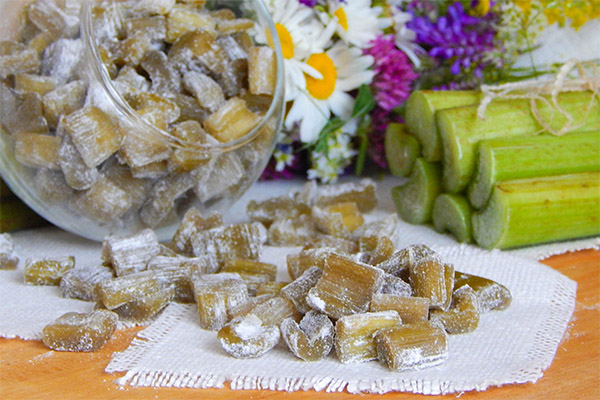
Ingredients:
- water - 0.6 l;
- rhubarb - 2 kg;
- sugar - 2.4 kg;
- icing sugar - 50 g.
Cooking method:
- Cut the plant into cubes and lower in boiling water for 2-3 minutes.
- Change the liquid, add sugar and stir, bring to a boil.
- Boil for 5-7 minutes and set aside for 12 hours.
- Repeat the procedure three times.
- Let the water drain, decompose the candied fruit on a baking sheet.
- Send to the oven to dry for 3-4 hours.
- The final stage is the roll of finished candied fruit in icing sugar. This is necessary so that the pieces do not stick together during storage.
Soup
This dish comes out especially rich and tasty. It is better to use young leaves of rhubarb, as they contain the most beneficial vitamins.
Ingredients:
- rhubarb - 0.3 kg;
- potatoes - 0.5 kg;
- greens, onions - 1 bunch;
- hard-boiled eggs - 3 pcs.;
- poultry meat - 0.5 kg;
- water - 2 l.
Cooking method:
- Prepare the broth and add chopped rhubarb into it.
- Bring to a boil and add potatoes.
- When ready, add the onion to the pan and set aside for 15–20 minutes.
- When serving, add a few pieces of egg and greens to the soup.
Kissel
Despite the fact that rhubarb is a vegetable, in preparation it is no different from a fruit. During cooking, it releases a large amount of water. Kissel leaves sour-sweet, which is very important in the summer heat season.
Ingredients:
- rhubarb - 0.5 kg;
- sugar - 2 tbsp;
- water - 1 l;
- starch - 2 tbsp.
Cooking method:
- Cut the stems into cubes, fill with water and pour sugar.
- Cook for 15 minutes over low heat, stirring occasionally.
- Drain the liquid into a separate container.
- Dilute starch in 0.5 cups of water and pour into jelly.
- Bring to a boil and boil for another 5 minutes.
- In total, the preparation of the drink takes 40 minutes.
Interesting facts about rhubarb

- The leaves of the plant are considered poisonous. However, for a lethal dosage, they need a very large number. They contain oxalic acid in such a high concentration that it can cause a burning sensation and swelling of the oral cavity and pharynx. Vomiting and panting are also possible.
- Rhubarb rhubarb (Rheum palmatum) is part of the Essiak tea (which also contains burdock rhizomes, sheep sorrel, American elm bark). He became popular thanks to nurse Rene Caissé from Canada. She used it as a folk remedy against a disease such as cancer. According to her, this recipe is an ancient heritage of the Ojibwe Indians. But the truth is that for the first time Canadians met with rhubarb at the beginning of the XIX century.
- Despite the fact that this plant belongs to vegetables, Americans call it a fruit. It got to the point that during the trial in 1947, a resolution was issued to consider rhubarb fruit, since it is used and prepared in the same way. For buyers, this turned out to be more than profitable. Customs duties on imported fruits are significantly lower compared to vegetables.
«Important: all information on the site is provided exclusively in fact-finding purposes. Before applying any recommendations, consult with a profile specialist. Neither the editors nor the authors are liable for any possible harm caused materials. "

